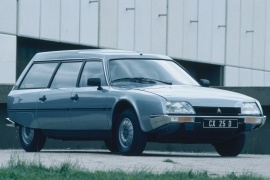CITROEN CX Break Models/Series Timeline, Specifications & Photos
First production year: 1976
Engines: Gasoline, Diesel
Body style: Wagon (station wagon, estate, combi, touring)
Citroen introduced the last refresh for its flagship model, the CX, which affected both the sedan and the station wagon, also known as Break.
By 1985, the CX started to show its age. Once a revolutionary vehicle in terms of design and fitted with top-of-the-line technologies, it was already outdated. Even though it already went through a facelift two years before, it was not enough. So the automaker made another improvement to make the car look younger. This time it worked, and the model remained the same until 1991, when it was retired.
Since the chromed metallic bumpers were no longer trendy, the French automaker replaced them with wrapped-around plastic ones. These were aerodynamically profiled to fit the car's overall look. Suddenly, the CX looked fresh again. In addition, depending on the trim level, they were body-colored, which increased the car's look even more. In this long-roof version, the slim rear bumper had to withstand the burden of loading and unloading stuff from the massive trunk, loaded through the wide liftgate.
Inside, there were more changes. Unfortunately, some of them were unique features for the CX lineup, such as the barrel-design gauge for the speedometer. Customers didn't appreciate those, so the automaker installed regular dials. In addition, the steering wheel sported a single-spoke design instead of the twin-spoke one offered on the Series I CX.
Starting with 1985, the CX received more fuel-injected versions that helped the large station wagon provide adequate power to the wheels. In addition, a turbo-diesel version with 120 PS (119 hp) helped the car get a very good fuel efficiency.
The last vehicle designed entirely by Citroen before the Peugeot takeover, the Citroen CX was marketed in Europe between 1974 and 1991.
Even from the beginning of its production the Citroen CX was appreciated, winning the European Car of the Year trophy in 1975.
The Citroen CX succeeded the legendary Citroen DS from which it borrowed its hydropneumatic suspensions. The engine was mounted transversely and tilted forward, a first in the market segment. With the new position of the engine, Citroen had to develop a new transverse gearbox which was later mounted on the Lancia Beta, Talbot Solara and others.
Even if it was shorter by 21 cm (8.26 inch) than the Citroen DS, the CX offered more interior room due to the new configuration.
The CX did not benefit from the hydraulic control of the gearbox that allowed manual gear change without a clutch pedal as the Citroen DX did.
Quite uncommon for the time, the Citroen CX featured standard 4-disc brakes, with vented discs at the front and also at the rear.
The exterior styling was the work of Robert Opron, inspired by the GS’ and the SM’s designs. Robert Opron succeeded to develop the new styling without making the CX look like a clone of another model.
In July 1982, the Citroen CX was slightly restyled and featured new names: CX 20, 20 TRE and 25 D. The exterior featured a restyled front mask, a flush grille and enlarged front bumper brackets. Inside, the cabin was fitted with new counter dials with orange numbers on a black background.
Also in 1982, some options became standard such as power steering, electric front windows and central door locking.
Citroen dodged the extinction bullet by joining the Peugeot group, but its projects went on, and the CX received a station wagon shape in 1975 as a 1976 model.
It was the last vehicle launched by Citroen before Peugeot took it over in April 1976, which already had almost 40 percent of the other French carmaker's stakes since 1974. The evolution of the large executive car didn't bother them and didn't stop them, even though it competed against the Peugeot 405 Station Wagon in the European market.
Unlike its sedan, fastback sibling, the CX Station wagon was 10 cm (3.9") longer and featured a rear liftgate with a flat loading area. The front fascia remained similar to the sedan version, but the car was different from the B-pillar behind. Its roof was raised above the rear seat passengers and more extended to the back. Citroen added a set of long side windows behind the rear doors.
Inside, the car featured the same front seats and dashboard as the sedan version. The carmaker installed a flat-folding and tumbled rear bench in the back, which led to a completely flat loading area. Moreover, there was no loading lip, and the trunk's floor was flush with the rear bumper. Thanks to its raised roof, it was an excellent car for camping and transporting motorcycles standing up. Also, Citroen managed to install a third row of seats, increasing the cabin's capacity up to eight occupants.
Under the hood, the carmaker offered a choice of four engines. Citroen provided only the 106 hp and the 115 hp gasoline engines at the launch, with the 128 hp version joining the range in 1978.


